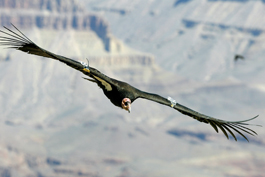home | metro santa cruz index | news | santa cruz | news article

Photograph by John Moir
Big Bird: A California condor's wing span can reach 10 feet.
El Condor Pasa
Santa Cruz author John Moir's account of how the fight to save the endangered California condor led to a disturbing discovery about lead.
By Jessica Lussenhop
Goldfinch," says John Moir almost inaudibly and in midsentence as one flits by in his peripheral vision. Although Moir, the author of Return of the Condor: The Race to Save Our Largest Bird From Extinction, is quite fond of our feathered friends, at the moment he's poring over two X-rays of deer in the back yard of his home in Santa Cruz, searching for fragments of shot. "They don't look like much, they're the size of a grain of salt or microscopic," he continues, holding the photographs up in the sunlight. The X-rays show luminous flecks, like a heavy snowfall, in the deer's rib cage where rounds of lead ammunition hit and shattered into hundreds of pieces (221 and 472, to be exact).
While he's looking at deer, Moir has condors on the brain. "This has been the primary reason that the bird was going extinct, and it's been the main hurdle moving forward," says Moir, who first fell in love with the behemoths after witnessing one in flight in the mid-'90s.
The California condor is an intelligent bird with a 10-foot wing span and a sharp beak that gives the impression it wouldn't need help from a bunch of environmentalist eggheads. Nevertheless, it took those eggheads over 20 years not only to puzzle out why the birds were dying but to navigate the political minefield that conservation work can be. "The future of the bird was so dicey that had a little thing gone different at a number of different points, we probably wouldn't have condors here," says Moir.
Accounts of those terribly important events are what comprise the book as it follows the Condor Recovery Program and conservationist Jan Hamber from the day that she captured condor number AC9, the last wild condor in existence, through the tumultuous events of the '80s and '90s, which pitted environmentalist against environmentalist in a battle royal over what was best for the buzzard: human intervention or total isolation. Though the fate of the bird rested at various points on the success of just one bird or just one scientist, there are now about 300 in the world, roughly 150 flying wild in the United States.
Though it's in many ways a happy story of humans able to reverse the damage of reckless hunting, pollution and habitat destruction, it's a continuing struggle to keep those 150 alive. Turns out those tiny specks in the X-rays are to blame for rereleased condors literally falling from the sky, poisoned by lead hidden in their diet of big game carrion. This means that even though the condors are flying free, they're intermittently brought down again for blood tests, hospitalization and aggressive chelating injections that force the bird to excrete the poison. "You can imagine a wild bird being put into this situation--it changes their behavior, it's just a horrible thing to have to do to them," says Moir. "But they save them more often than they lose them."
Just this past July, a ban on lead ammunition went into effect, forcing big game hunters to switch to more expensive copper. Not surprisingly, the ban had some heavyweight opposition. "Some gun groups, most notably the NRA, have opposed this. The condor program was forced to continue to pile up evidence," says Moir.
That scary pile of evidence has made more than conservationists question how far that lead snowfall can blow. "A physician in North Dakota--he was a hunter, he was not part of the condor program--heard a talk about [the lead issue]," says Moir. "He thought to himself, 'Whoa, I'm a hunter. I could be at risk of consuming lead.'" The result was a study on packets of venison donated to North Dakota food pantries revealing that 59 percent of them contained metal fragments. "Humans eat a piece of venison and they're not going to see the lead. They're not going to feel it. It's too small," Moir says.
Just like the condor, humans may be unwittingly poisoning themselves; the litany of symptoms, from headache to weakness, can later result in high blood pressure or seizure, and lead is terribly dangerous for children and pregnant women. More research is being done that could eventually lead to more lead-ammunition bans. Moir says that on top of being a hopeful message about the effectiveness of conservation, his book will help people see how close our struggle is with the wild animals we separate ourselves from. "There's this gradual understanding that we are all linked together," he says. "There is no 'out there.' There is no 'nature.' We are nature and nature is us."
JOHN MOIR will read from 'Return of the Condor: The Race to Save Our Largest Bird From Extinction' and give updates on the Condor Recovery Program on Thursday, Nov. 6 at 7:30pm at Capitola Book Café, 1475 41st Ave., Capitola; 831.462.4415.
Send a letter to the editor about this story.
|
|
|
|
|
|